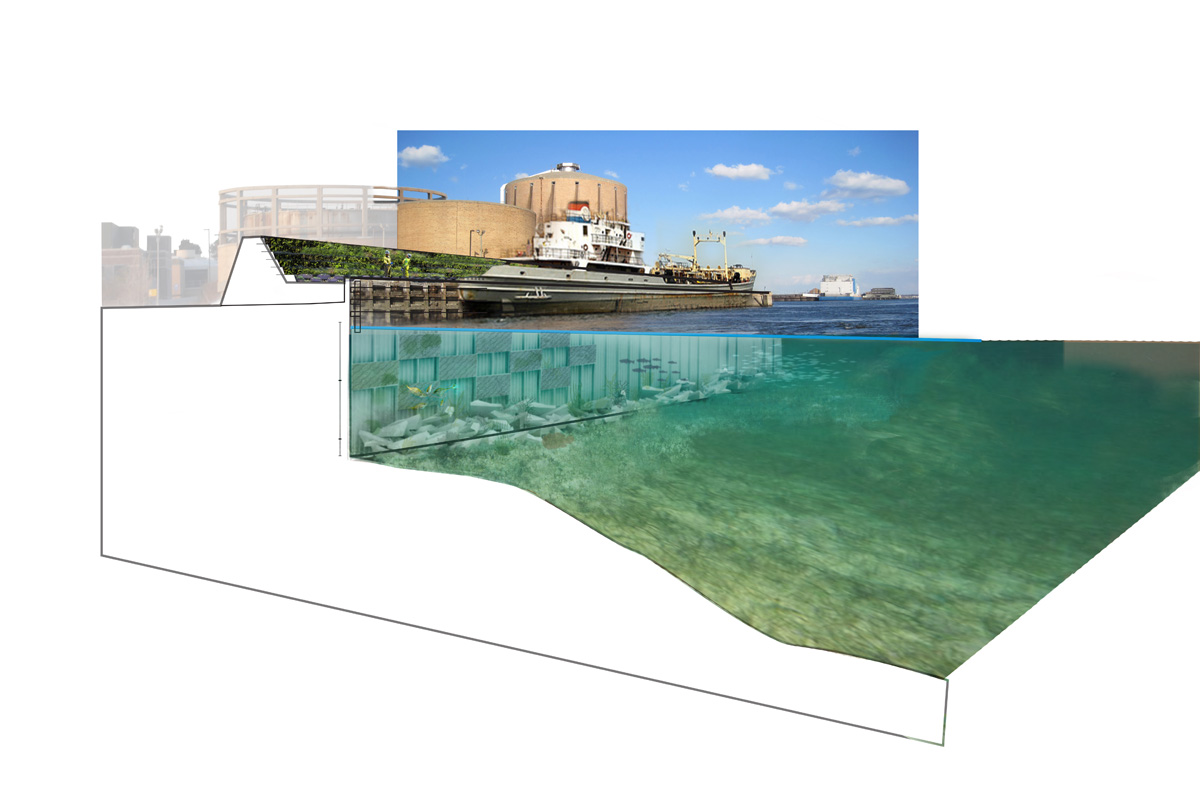
PROJECT PAGES: Hunts Point Lifelines
BACKGROUND
Developed by: PennDesign/OLIN with HR&A Advisors, eDesign Dynamics, Level Infrastructure, Barretto Bay Strategies, McLaren Engineering Group, Philip Habib & Associates, Buro Happold
The Hunts Point peninsula is a single square mile of the South Bronx in New York City, and serves as the hub of the food supply for 22 million people in the Northeast U.S., housing its produce, fish, and meat markets. Its $5 billion annual economy provides over 20,000 jobs to the region. Directly adjacent to the industrial area is a vibrant residential community cut off from its waterfront by thousands of daily truck trips. Residents of Hunts Point are located in the poorest congressional district in the United States and have little access to fresh food from the wholesale markets, often exasperating health disparities.
Although Hurricane Sandy’s arrival at low tide spared much of Hunts Point, the area is nonetheless vulnerable to flooding. Climate change and sea level rise are threat multipliers to a neighborhood already challenged by poverty, isolation, and environmental degradation.
Location: Hunts Point, Bronx, NYC
Award: $20 Million
Implemented By: New York City Economic Development Corporation
PROPOSAL
The Hunts Point Lifelines proposal outlined four “Lifelines” that demonstrate a working waterfront that could be replicated in maritime industrial areas across the region.
Flood Protection “Levee Lab”: Flood protection that keeps a modernizing food hub dry is integrated with a waterfront greenway for residents to walk, bike, or jog. A “Levee Lab” of flood protection interventions, designed ecologies, and applied material research creates a string of platforms over the water for recreation, which in turn improves public health, and brings awareness and access to the waterfront.
Livelihoods: New techniques for construction, maintenance, and research for the “Levee Lab” ensure the community can participate in building its protective infrastructure by providing jobs and training to residents.
Maritime Emergency Supply Lines: New pier infrastructure on the site of a marine transfer station can build on emerging federal programs to create marine highways for delivering vital goods and supplies to East Coast waterfront communities when roads are impassable.
Cleanways: A tri-generation plant could create low-cost, low-carbon cooling and a micro-grid island in an emergency when the City’s main grid goes down. A series of strategies could be introduced to refocus the neighborhood around transit and connect residents to the waterfront greenway.
View the team’s full original proposal here.
IMPLEMENTATION PROGRESS
In May 2020, the Economic Development Corporation released the Hunts Point Resiliency Feasibility Study, a culmination of the work undertaken by the community-based Advisory Working Group (AWG) since 2015 to guide resilience planning in Hunts Point. Based on the Feasibility Study and on community priorities identified by the AWG, the City launched the Hunts Point Energy Resiliency project, to support the resilience of Hunts Point and protect a critical hub of the City’s food supply by establishing: 1) A tri-generation microgrid to provide back-up power to the Hunts Point Food Distribution Center (FDC), the single largest cluster of food sources for the City; 2) Solar energy and storage for two local schools (P.S. 48 and M.S. 424), providing year-round sustainable energy and back-up power that enables the schools to act as community shelters during emergencies; and 3) Mobile generators that can provide back-up power to other important citywide food distributors and FDC employers during emergencies.
Construction on the P.S. 48 and M.S. 424 solar energy and storage components is expected to begin in early 2023. Construction on the back-up generator for 600 Food Center Drive at the FDC will start in 2024. In June 2022, Mayor Adams and the Hunts Point community announced the Hunts Point Forward Plan, a 15-year community-driven plan to foster workforce development, improve community health, promote environmental justice, and upgrade key infrastructure in Hunts Point. The Energy Resiliency project described above is now encompassed within the new Plan. The Plan is backed by an initial City commitment of $140M, including $100M towards Produce Market redevelopment and $40M for shoreline restoration and other improvements at Barretto Point Park.
Finally, NYCEDC was awarded a $14.68M FEMA Building Resilient Infrastructure and Communities (BRIC) Grant for dry-floodproofing the Meat Market and 600 Food Center Drive, identified by the Hunts Point Resiliency Feasibility Study as two of the facilities in the FDC most at-risk from storm surge flooding.
Check out the project website here.
Budget: $85.68 million ($20M CDBG-DR grant through Rebuild by Design, $51M City Capital and additional CDBG-DR, $14.68M FEMA Building Resilient Infrastructure and Communities (BRIC) Grant)
Press:
- Multiple city agencies joining forces in Hunts Point transformation plan, News12 (June 2022)
- Mayor Adams, Hunts Point Community Leaders Release Comprehensive Plan to Create Economic Opportunity, Improve Quality of Life in Hunts Point, NYC.gov (June 2022)